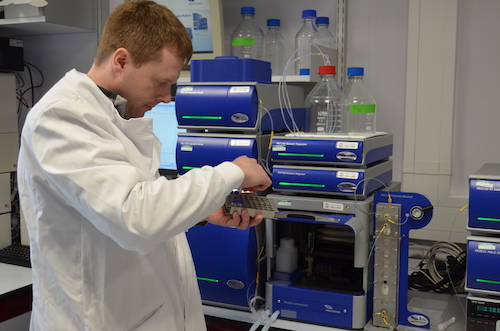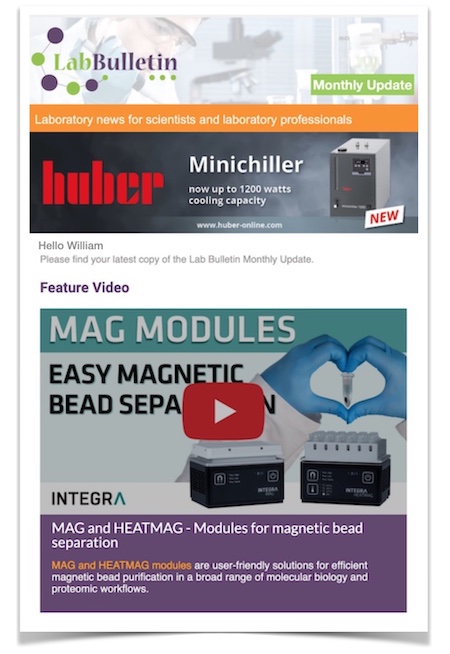Members Login

Channels
Special Offers & Promotions
Unlocking the Puzzle of Neurodegenerative Diseases

Postnova Analytics reports that the Department of Molecular Biology & Biotechnology at the University of Sheffield (UK) is using their AF2000 Field Flow Fractionation system to investigate the mechanism of amyloid formation, a protein mis-folding process implicated to be the cause of Alzheimer’s and other neurodegenerative diseases.
Understanding the causes of neurodegenerative diseases is a huge challenge. Outbreaks of BSE (commonly known as mad cow disease) and the rise of Alzheimer’s as a leading cause of death has meant that there is increasing pressure to find a cure. These two diseases are characterised by the accumulation of fibrous material called "amyloid" in the brain. Amyloid has been shown to consist of naturally occurring proteins assembled into fibrils, carefully organised thread-like molecules. Whether or not this protein-based material is the direct cause for deterioration of brain tissue in patients suffering from these diseases is a matter of some controversy. However, it is clear to all that these proteinaceous fibres are closely associated with the pathology: mutations in genes coding for these proteins cause the early onset of the disease and premature death. Another cause for hope is that this pattern of events may be common to almost all neurodegenerative diseases, including Parkinson’s and Huntington’s, and a large number of other diseases including certain forms of cancer, diabetes and stroke.
Dr Rosie Staniforth, Head of the research group at University of Sheffield commented "It is exciting to think that understanding the mechanism of amyloid formation may be a step towards a universal cure since, so far, therapies have only been targeted at alleviating symptoms but cannot prevent or halt the onset of these devastating diseases".
In order to define the molecular events responsible for the assembly reactions of amyloid beta protein, researchers either need to measure directly all the species involved or infer them from a more limited set of data. One of the key problems with current analyses is that while experimental data suggests that large populations of intermediate species form early in the assembly reaction of amyloid protein, and that these species may be responsible for its neurotoxicity, theoretical models are unable to incorporate these explicitly because very few methods for quantifying these during the assembly reaction exist. The problem of characterising this reaction in vivo is very challenging.
Field Flow Fractionation (FFF) provides a method for analysing the distribution of species in solution and has huge advantages over SEC-MALS as a method for fractionation and characterisation of complex species. This is because aggregating species usually adhere to the solid phase of chromatography columns: beneficially in FFF, the absence of a solid phase means this problem is largely removed. Also, the range of species that can be analysed in a single run by FFF is enormous, from small peptides to our larger aggregates microns in size. This is exactly what we need to quantify the species we can see by Electron Microscopy.
Dr Staniforth added "Postnova was a real surprise to us! We obtained money from the UK Biotechnology and Biological Sciences Research Council (BBSRC) to buy this equipment and knew the real challenge was going to be working with amyloid beta, notorious as “the peptide from hell”. We set the bar high by challenging different suppliers to produce data for us within a few days. Postnova came up trumps as their AF2000 FFF machine is truly user-friendly. It gave us the confidence that we were not facing a long period of method optimisation to get to where we needed. We particularly liked the frit-inlet option and the stream splitter which has allowed us to minimise concentrating the peptide on the system, something which leads to artefactual aggregation and incorrect conclusions. Postnova produced some very exciting preliminary data which we are now able to reproduce".
Despite having only had their AF2000 system for a matter of weeks, the University of
Sheffield has already produced great data on amyloid beta protofibrils that match the information they had from electron microscopy but now reveals their contribution to the sample quantitatively. Sheffield researchers can now answer the question as to how significant the species they observe by electron microscopy is to the process of protein assembly and what percentage of the whole sample is in this oligomeric form.
The Postnova AF2000 is a high-performance Flow Field-Flow Fractionation (FFF) platform for separation of proteins, macromolecules and nanoparticles. Modular in design, the AF2000 incorporates the combined experience, expertise and technological advances from Postnova Analytics' nearly two decades of leadership in FFF. Incorporating a range of FFF modules in a single integrated system to provide universal separation, the AF2000 offers more flexibility, better performance and more robust results than any system before.
Media Partners


